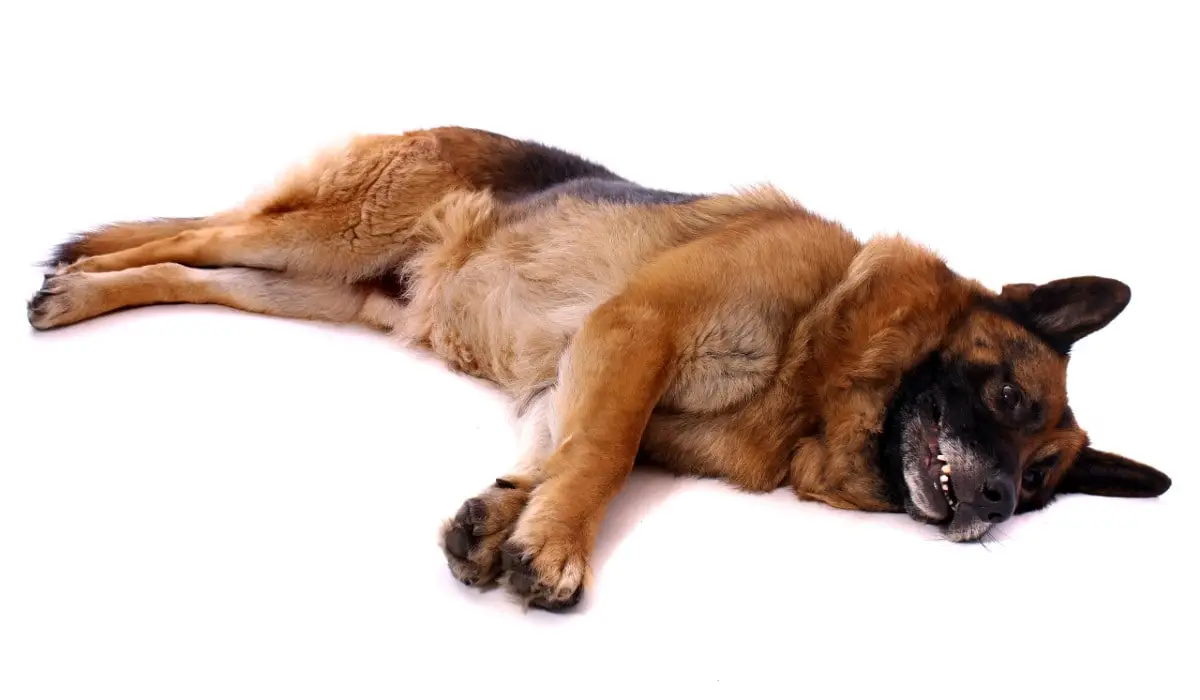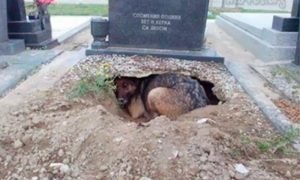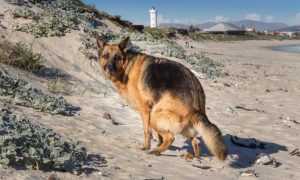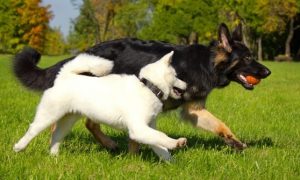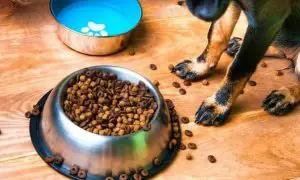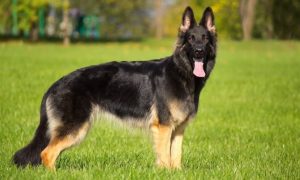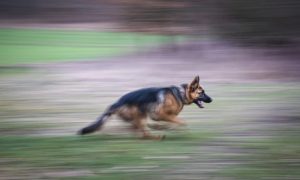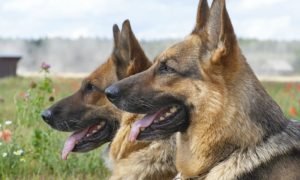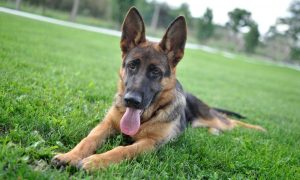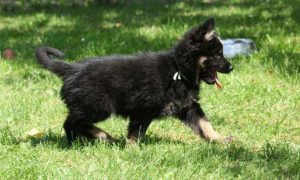Gastric dilatation-volvulus, GDV, is commonly referred to as twisted stomach, twisted gut, or dog bloat.
GDV is a life-threatening condition. There’s a 30% to 50% mortality rate associated with this condition. If you have a high-risk breed, it’s crucial that you know the signs and symptoms of dog bloat.
You must go to your veterinarian or an emergency veterinarian immediately if you suspect your dog is potentially in the beginning stages of bloat.
Not all dogs that have gastric dilatation end up having volvulus. Your dog can have bloat, which is when the stomach fills up with gas without it twisting or turning in on itself.
If your dog has bloat combined with the stomach twisting, their blood supply is cut off, which causes other immediate issues.
Symptoms of Twisted Gut
- Stomach enlarged with air (bloated)
- Belching
- Vomiting
- Retching
- Abdominal pain
- Restless/Pacing
- Shallow rapid breathing
- Excessive drooling
- Pale gums and tongue
- Confusion/Disorientated
Initially, your dog may be restless, but after a period of time, they may lack the desire to move or be unable to move due to going into shock or because of intense abdominal pain.
If your dog is experiencing any of the above symptoms, it is crucial you get to your veterinarian or an emergency vet ASAP.
Do not waste precious time calling your vet because they will tell you to bring your dog in. Load up your dog and call as you are en route.
Alert your vet you are on your way, the symptoms your dog is experiencing, and how long it’s been since you first noticed the symptoms.
How do you tell the difference between gastric bloat versus twisted gut? You don’t. You let a vet determine this.
The only way to tell the difference is with an x-ray. If you have the slightest concern, this could be happening to your dog; you need to get your dog to a vet immediately.
When it comes to addressing this condition, it is much better to be safe rather than sorry.
When a full-blown case of GDV occurs, the stomach is bloated, and it turns or twists on itself.
The entry to the stomach and the exit from the stomach is cut off, so there’s no way that your dog can effectively relieve the air and the pressure.
If your dog is only experiencing bloat, their stomach has expanded and filled up with gas.
To relieve the pressure, your dog will do a lot of belching and may even successfully vomit. These actions will reduce your dog’s stomach back to its normal state, and all is well.
If your dog’s stomach has twisted on itself, you’ll see your dog trying to belch or retch, but nothing will come out.
The spleen is attached to the greater curvature of your dog’s stomach. When the stomach flips on itself, it pinches off the spleen and the vessels going to the spleen.
This now causes the abdominal vessels to become cut off, and blood flow to the abdominal organs stop.
When blood flow to the abdominal organ stops, blood flow back to the heart is significantly reduced, and this will cause shock to occur.
If your dog has gone into the stage of shock, the symptoms are pale gums, shallow rapid breathing, and unconsciousness.
Your dog can go from perky and be playing to pale and unconscious in a matter of potentially 20 minutes to an hour after this condition sets in.
If you don’t seek veterinary care immediately and torsion occurs, your dog’s stomach will rupture, peritonitis will happen, and your dog will die. This condition is life-threatening, so time is of the essence.
What Causes Twisted Gut?
Veterinarians cannot pinpoint exactly what causes GDV. However, there are a lot of theories on known contributing factors as well as some genetic predispositions.
It has been determined that dogs with deep narrow chests can be more prone to bloat. Breeds that are large in size, have deep chests, and have high energy levels are even more susceptible to bloat.
Breeds Most Prone to Bloat
- Afghan
- Akita
- Alaskan Malamute
- Basset Hound
- Bernese Mountain Dog
- Bloodhound
- Boxer
- Doberman
- Great Dane
- Great Pyrenees
- German Shepherd
- German Shorthaired Pointers
- Golden Retriever
- Gordon Setter
- Irish Setter
- Irish Wolfhound
- Labrador Retriever
- Newfoundland
- Old English Sheepdog
- Rottweiler
- Shiloh Shepherd
- Saint Bernard
- Standard Poodle
- Weimaraner
The above list is a heads-up to owners who love these breeds. If your dog didn’t make the list, please be aware that bloat can happen to any breed.
Do Raised Feeding Bowls Cause Dog Bloat?
Does the level at which your dog eats contribute to bloat? Maybe. Maybe not.
In 2000 Purdue did a bloat study, and one of the things they concluded is fifty percent of dogs fed from an elevated food dish may be more prone to bloat.
Advocates of elevated food dishes point out that fifty percent of the dogs in this study that weren’t fed from elevated food dishes also bloated.
Food and Water-Related to Dog Bloat
The rate at which your dog eats or drinks plays a role in bloat. If your dog inhales their food or gulps large amounts of water in a short period of time, a ton of air is being ingested into their stomach, which can lead to bloat.
The type of food you feed your dog can contribute to bloat. The majority of dry kibble on the market contain carbohydrates which are sourced from corn, wheat, rice, soy, oatmeal, etc. Carbohydrates are fermentable, and fermentation produces gas.
Dogs do not nutritionally require carbohydrates. The more carbohydrates you feed to a species that doesn’t need them results in more gas that’s going to be produced.
If the gas can be expelled, then all is well, but if the gas becomes trapped in the stomach, then that would, in theory, predispose your dog to have an increased risk of bloat.
By feeding a diet with no grains, your dog has less fermentation in the stomach. Therefore, there’s less risk of abdominal gas accumulation in the stomach.
Don’t feed your dog one large meal. Excessive amounts of food can increase your dog’s risk of bloat.
Instead, provide two smaller meals and monitor their water consumption during and after meals. Some experts recommend withholding water for an hour to give your dog time to process their food.
If your dog inhales their food quickly, it is important to slow down their consumption rate. To do this, you can try spreading your dog’s food out on a cookie sheet, or you can get a bowl that is designed to slow down how quickly your dog eats.
If you have several dogs and feed them together sometimes, the competition factor will cause your dogs to eat faster.
Put your dogs in different rooms of your house, so there’s less competition. Your dogs eating at a slower pace will help reduce the amount of air being swallowed and ingested.
Exercise and Dog Bloat
Be sure your dog is getting enough exercise daily to maintain muscle tone and range of motion, which will help decrease cortisol levels and facilitate optimal body function.
Exercise and play after eating is a big no-no. Restrict exercise or play for at least one hour after your dog has consumed a meal.
If you have a high-risk breed, restrict exercise or play one hour before mealtime and one hour after.
What to Expect if Your Dog has Bloat
When you get your dog to the vet office, one of the first things that will happen is an IV line. The IV is critical for helping to maintain blood pressure, administer medications to help combat the potential shock that your dog could be in, and administering pain medication.
The second thing the vet will do is try and release the air in your dog’s stomach.
They will do this with an esophageal tube which will be put down your dog’s throat. If this doesn’t work, your dog’s stomach will be injected with a long and sharp needle to relieve the pressure, so your dog’s stomach doesn’t rupture.
Next, they’ll take x-rays to determine if your dog has a case of just gastric dilatation or if there’s volvulus or twisting.
If twisting has occurred, your dog will go immediately into surgery to have the stomach untwisted and sewn in place once your dog is stable.
There are always a lot of potential consequences to surgery. If you don’t have surgery and your dog’s stomach is twisted, your dog will die.
However, there is still a risk of your dog dying during surgery.
As your dog’s stomach is untwisted, your dog can undergo what’s called reperfusion injuries. All of the blood flow is reestablished through your dog’s vital organs can cause heart palpitations and electrical abnormalities within your dog’s heart.
There’s a critical perioperative period from when your dog goes into surgery and for the next several days after surgery.
Just because your dog makes it out of surgery, there’s still a risk of your dog potentially dying.
If you have a high-risk breed for bloat, you can hopefully reduce your dog’s risk by implementing the following suggestions:
- Proper exercise daily
- No exercise, playing, or roughhousing at least one hour before meals and one hour after meals
- Monitor meals and water intake
- Feed a diet that eliminates grain, carbohydrates, preservatives, by-products, food coloring, and fillers
- Feed at least twice per day versus one large meal
Please know, you can do everything right and can still have a dog that bloats.
Every dog owner needs to be aware of bloat and take it seriously.
If you think your dog has any symptoms of bloat, getting them to a veterinarian or an emergency hospital ASAP may be the difference between life and death.

